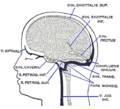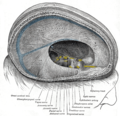Dural venous sinuses
| Dural venous sinuses | |
|---|---|
 Illustration of the dural venous sinuses | |
 Dural venous sinuses | |
| Details | |
| Identifiers | |
| Latin | sinus durae matris |
| MeSH | D003392 |
| TA98 | A12.3.05.101 |
| TA2 | 4846 |
| FMA | 76590 |
| Anatomical terminology | |
The dural venous sinuses (also called dural sinuses, cerebral sinuses, or cranial sinuses) are
arachnoid granulations. They mainly empty into the internal jugular vein.[2]
Cranial venous sinuses communicate with veins outside the skull through emissary veins
. These communications help to keep the pressure of blood in the sinuses constant. The major dural venous sinuses included the superior sagittal sinus, inferior sagittal sinus, transverse sinus, straight sinus, sigmoid sinus and cavernous sinus. These sinuses play a crucial role in cerebral venous drainage. A dural venous sinus, in human anatomy, is any of the channels of a branching complex sinus network that lies between layers of the dura mater, the outermost covering of the brain, and functions to collect oxygen-depleted blood. Unlike veins, these sinuses possess no muscular coat.
The major dural venous sinuses included the superior sagittal sinus , inferior sagittal sinus, straight sagittal sinus, sigmoid sagittal sinus, transverse sagittal sinus and cavernous sinus
Venous sinuses
| Name | Drains to |
| Anterior | |
Sphenoparietal sinuses
|
Cavernous sinuses |
| Cavernous sinus | Superior and inferior petrosal sinuses |
| Midline | |
| Superior sagittal sinus | Typically becomes right transverse sinus or confluence of sinuses |
| Inferior sagittal sinus | Straight sinus |
| Straight sinus | Typically becomes left transverse sinus or confluence of sinuses |
| Posterior | |
| Occipital sinus | Confluence of sinuses |
| Confluence of sinuses | Right and left transverse sinuses |
| Lateral | |
| Superior petrosal sinus | Transverse sinuses |
| Transverse sinuses | Sigmoid sinus |
| Inferior petrosal sinus | Internal jugular vein |
Sigmoid sinuses |
Internal jugular vein |
Paired venous sinus [3]
Structure
The walls of the dural venous sinuses are composed of
lymph vessels. They differ from other blood vessels in that they lack a full set of vessel layers (e.g. tunica media) characteristic of arteries and veins. They also lack valves (in veins; with exception of materno-fetal blood circulation i.e. placental artery and pulmonary arteries both of which carry deoxygenated blood).[citation needed
]
Clinical relevance
The sinuses can be injured by trauma in which damage to the
hemorrhagic infarction or cerebral edema with serious consequences including epilepsy, neurological deficits, or death.[4]
Additional images
-
Dural veins
-
Sagittal section of the skull, showing the sinuses of the dura.
-
Dura mater and its processes exposed by removing part of the right half of the skull, and the brain.
-
The sinuses at the base of the skull.
-
Major sinuses and their tributaries
References
- ISBN 0-7817-5154-3. Archived from the originalon 2011-05-14. Retrieved 2006-01-27.
- ^ a b Gaillard, Frank. "Dural venous sinuses | Radiology Reference Article | Radiopaedia.org". Radiopaedia.
- ISBN 978-93-5466-477-9.
- PMID 10066840.
External links
Wikimedia Commons has media related to Dural venous sinuses.





